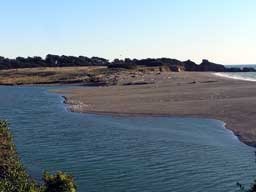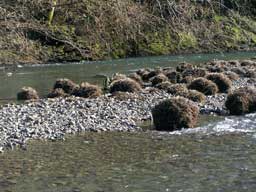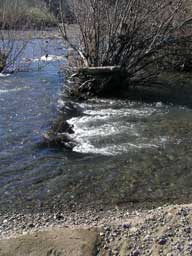2/20/2006 Peter
 “The river mouth has formed a double sand spit, an atypical configuration — a small ‘counter-spit’, growing in the reverse (south) direction of the main spit’s growth, overlaps the ocean side of the spit, and deflects the shrunken mouth southward about a hundred feet. “The river mouth has formed a double sand spit, an atypical configuration — a small ‘counter-spit’, growing in the reverse (south) direction of the main spit’s growth, overlaps the ocean side of the spit, and deflects the shrunken mouth southward about a hundred feet.
It partially chokes the mouth, so the lagoon stands above the low tide.” |
 “The washover terrace formed by the storm is unusually wide, filling much of the western bed of the lagoon that was deep water last year.It has persisted in the absence of flood flows that usually trim and steepen the back of the barrier spit.” “The washover terrace formed by the storm is unusually wide, filling much of the western bed of the lagoon that was deep water last year.It has persisted in the absence of flood flows that usually trim and steepen the back of the barrier spit.” |
 “Upstream of Valley Crossing on the Wheatfield Fork, tough clumps of torrent sedge tenaciously persist on a gravel bar, despite the intense flood flows.They look like a herd of giant riparian hedgehogs this time of year, before they leaf out.” “Upstream of Valley Crossing on the Wheatfield Fork, tough clumps of torrent sedge tenaciously persist on a gravel bar, despite the intense flood flows.They look like a herd of giant riparian hedgehogs this time of year, before they leaf out.” |
 “Some large rootwads were recruited in the main channel bed, lodged in place by the bole of the tree, caught in branches of standing trees.This is a large alder, a riparian hardwood species that lives fast, gets big, and dies early compared to redwoods. Its root wad will decay much faster than a redwood, but it serves the same function, with faster turnover.” “Some large rootwads were recruited in the main channel bed, lodged in place by the bole of the tree, caught in branches of standing trees.This is a large alder, a riparian hardwood species that lives fast, gets big, and dies early compared to redwoods. Its root wad will decay much faster than a redwood, but it serves the same function, with faster turnover.” |
 “More ‘hedgehogs’ of dormant torrent sedge right in the active channel, stabilizing the gravel bed and acting like a grade control structure, damming up gravel behind them, raising the bed enough to create a “jump” (turbulent flow where water level changes abruptly). They are lined up because they outline a former bar shoreline position, where the seedlings establish (they don’t germinate under flowing water!).The bar is long gone, but the torrent sedge tussocks remain and provide structure of the ‘ghost’ of the former bar edge. It’s remarkable that they survived the New Years floods, and all the gravel abrasion. They have extremely tough roots and tops, very fibrous, like palm stalks.” “More ‘hedgehogs’ of dormant torrent sedge right in the active channel, stabilizing the gravel bed and acting like a grade control structure, damming up gravel behind them, raising the bed enough to create a “jump” (turbulent flow where water level changes abruptly). They are lined up because they outline a former bar shoreline position, where the seedlings establish (they don’t germinate under flowing water!).The bar is long gone, but the torrent sedge tussocks remain and provide structure of the ‘ghost’ of the former bar edge. It’s remarkable that they survived the New Years floods, and all the gravel abrasion. They have extremely tough roots and tops, very fibrous, like palm stalks.” |